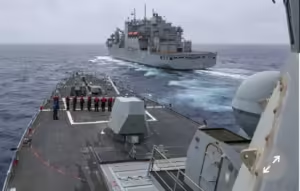“Tragic Sailing Boat Collision: How a Perfect Storm of Errors Led to a Catastrophic Crash
In the early hours of September 3rd, the tranquil waters off the coast of Newport turned into a scene of chaos and devastation as two sailing boats collided in what is being described as one of the worst maritime accidents of the year. The incident, which resulted in the sinking of one vessel and injuries to several passengers, has left the sailing community in shock and raised serious questions about maritime safety protocols.
The accident occurred around 1:30 a.m. local time, as a dense fog had enveloped the area, reducing visibility to near zero. The two vessels involved were the “Seafarer,” a 35-foot sloop on a leisure cruise, and the “Windrider,” a 40-foot racing yacht. According to preliminary reports, the Seafarer was on a return leg from a late-night fishing expedition, while the Windrider was participating in a nighttime regatta.
Eyewitnesses who were docked nearby described the eerie scene of the fog-drenched waters, punctuated by the sudden, jarring sound of the collision. Rescue teams arrived to find the Seafarer rapidly taking on water, with its hull breached and its crew struggling to stay afloat. The Windrider, though suffering damage, managed to stay afloat and return to shore.
Investigators are now piecing together the chain of events that led to this tragic accident. The National Transportation Safety Board (NTSB) has launched a full investigation, but initial findings suggest a complex web of contributing factors. Here’s a closer look at the elements that appear to have played a role in this maritime disaster.
**1. Inadequate Navigation Lights and Communication Failures**
One of the primary factors identified was the failure of both vessels to adhere to proper navigation light protocols. The Seafarer, a smaller boat, was reportedly using outdated navigation lights that were not sufficiently bright to be seen through the dense fog. Meanwhile, the Windrider, while equipped with modern lighting, was found to have its lights dimmed, a common practice among racing yachts to reduce glare. This combination of insufficient lighting made it nearly impossible for either vessel to detect the presence of the other in time to avoid the collision.
Communication between the two boats also played a critical role. The Seafarer’s crew had attempted to contact the Windrider via radio to alert them of their position, but poor reception and unclear transmission led to a lack of effective communication. The Windrider’s crew, preoccupied with race strategies and maneuvering, failed to notice the distress signals until it was too late.
**2. Navigation Errors and Misjudgments**
Compounding the issue was a significant navigational error. The Seafarer’s captain was reported to have misjudged the boat’s position, heading directly into the path of the Windrider, which was sailing on a fixed course as per racing regulations. The dense fog, coupled with the captain’s reliance on outdated navigational charts, created a dangerous situation where spatial awareness was severely compromised.
On the other hand, the Windrider’s racing crew, focused on optimizing their performance and maintaining speed, had neglected to adjust their course to account for potential obstacles. The high speed at which the Windrider was traveling reduced its ability to maneuver quickly enough to avoid the collision, illustrating a classic case of high-speed racing contributing to a disaster in adverse conditions.
**3. Weather Conditions and Environmental Factors**
Weather conditions played a critical role in the accident. The fog that blanketed the area had formed rapidly, catching both vessels off guard. In such conditions, even experienced sailors can find themselves in peril if not properly prepared. The lack of radar on the Seafarer made it particularly vulnerable in such low-visibility situations. Though the Windrider was equipped with radar, its effectiveness was reduced due to the density of the fog.
In addition to the fog, reports indicate that there were strong undercurrents in the area, which may have affected the handling of both boats. The Seafarer, being a smaller vessel, was particularly susceptible to these currents, which might have contributed to its deviation from its intended path.
**4. Human Factors and Decision-Making**
Human error was a significant factor in the tragedy. The crew of the Seafarer, having been at sea for hours and fatigued from their fishing expedition, may have been less vigilant in monitoring their surroundings and maintaining proper watch. Fatigue, combined with the challenging conditions, likely impaired their decision-making abilities.
Similarly, the Windrider’s crew, while experienced, was under immense pressure to perform well in the race. This pressure may have led to a tunnel vision effect, where the focus on race strategy overshadowed the importance of safe navigation and collision avoidance.
**5. Safety Protocols and Emergency Response**
In the aftermath of the collision, the response from both the Coast Guard and local emergency services was swift and commendable. However, the incident has highlighted the need for enhanced safety protocols and emergency preparedness. Both vessels were equipped with life vests and distress signals, but the effectiveness of these measures was limited by the severity of the accident and the challenging conditions.
The Seafarer’s crew was rescued by a nearby boat that responded to their distress signals, but not before the vessel had sunk completely. Fortunately, all crew members were accounted for, though several sustained injuries ranging from minor to serious.
**Conclusion**
The collision between the Seafarer and the Windrider serves as a stark reminder of the myriad factors that can lead to maritime accidents. From navigation errors and communication failures to the impact of environmental conditions and human factors, the tragedy underscores the importance of rigorous adherence to safety protocols and constant vigilance.
As the investigation continues, recommendations for improving navigation safety and communication procedures are expected to be made. The hope is that lessons learned from this tragic incident will lead to enhanced maritime safety measures, preventing similar accidents in the future and ensuring that the waters remain safe for all sailors.